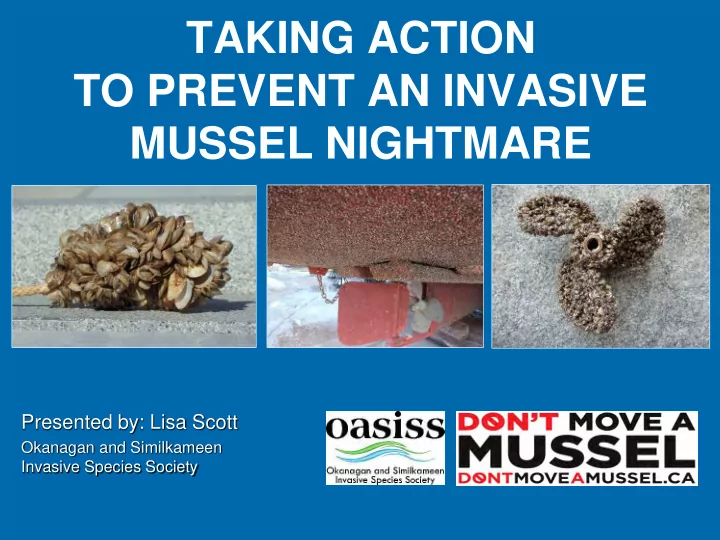

TAKING ACTION TO PREVENT AN INVASIVE MUSSEL NIGHTMARE Presented by: Lisa Scott Okanagan and Similkameen Invasive Species Society
OASISS – who we are • A non-profit society established in 1996. • Diverse cross-section of members. • Broadened mandate to encompass invasive species in 2012. • Address invasive species and their pathways of spread through prioritization and multi-stakeholder cooperative coordination • Responsible for the coordination, implementation and evaluation of on-the-ground treatment. • Involved in public information and community stewardship programs.
Okanagan watershed and the Similkameen watershed
Zebra / quagga mussel biology Freshwater mussels Ability to attach to solid surfaces by byssus threads Filter feeders Free swimming microscopic larvae Adults can live without water for up to 30 days Source: BC Government
Native mussels vs zebra / quagga mussels Source: BC Government
Why be concerned? Invasive mussels can…. Clog pipes, water intake systems and municipal water supply “The bane of water systems and power plants in the Great Lakes area” Compete for food with native species and deplete food sources for fish Decrease the quality of the recreational experience and impact tourism Source: BC Government
Could they survive? *Based on probability of survival and arrival Source: Therriault et al . 2012
Source: Manitoba Conservation and Water Stewardship A substrate sampler before.... A substrate sampler after being set in the south basin of Lake Winnipeg at Gimli for three months.
How fast have they spread ?
How fast have they spread?
How fast have they spread?
How fast have they spread?
How fast have they spread?
How fast have they spread?
How fast have they spread?
How fast have they spread?
How fast have they spread?
How fast have they spread?
How fast have they spread?
How fast have they spread?
How fast have they spread?
How fast have they spread?
How fast have they spread?
How fast have they spread?
How fast have they spread?
How fast have they spread?
How fast have they spread?
How fast have they spread?
How fast have they spread?
How fast have they spread?
How fast have they spread?
How fast have they spread?
How fast have they spread?
How fast have they spread?
How fast have they spread?
How fast have they spread?
“If they get over the Continental Divide, then British Columbia, Idaho, Washington and Oregon are all vulnerable. No matter how many inspection stations we have, they’ll just float downriver. And it’s not just a tourism matter. We estimate it will cost the region a half-billion dollars a year for the rest of our lives just to manage impact on hydro, irrigation and fisheries, especially our salmon habitat.” Matt Morrison, CEO of the Pacific Northwest Economic Region (December 1, 2016)
Estimated Economic Impact for the Okanagan Basin We estimate that the annual total $ 43,000,000 cost of a mussel invasion to exceed 43 million per year in the first few years from lost revenues and added maintenance of aquatic We could be 43 million richer infrastructure, for every year we keep the mussels out. … in addition to irreparable ecological damage.
British Columbia – Summary Sector Annual % total costs impact $6,524,532 15.2 Hydropower generation $14,800,000 34.4 Agriculture - Irrigation $9,251,608 21.5 Municipal water supplies $12,385,962 28.8 Recreational boating ????? Fisheries, Tourism, Property values Total $42,962,102
The current level of Montana’s AIS funding, approximately $6.5 million, is roughly 3 percent of the estimated $234 million annual costs for invasive mussel mitigation and lost revenue.
BC Invasive Mussel Defence Program It is MANDATORY for ALL watercraft to stop at road side inspection stations. Watercraft includes sailboats, motorboats, kayaks, canoes and paddle boards. Source: https://www2.gov.bc.ca/gov/content/invasive-mussels
BC now has 2 dogs trained to detect invasive mussels
Regional Aquatics Program Monitor the local waters for invasive mussels Raise awareness about invasive mussels and other AIS, and encourage behavior change: CLEAN-DRAIN-DRY
Regional Program Mussel Substrate Monitors OASISS worked cooperatively with yacht clubs, marinas, BC Parks and municipalities to monitor the local waters for invasive mussels in 16 locations PC: Neil Bousquet
Mussel Veliger Monitoring OASISS collected water samples from 20 different locations and partnered with the Osoyoos Lake Water Quality Society for additional monitoring PC: Neil Bousquet
Mussel Veliger Monitoring In the Columbia Basin Source: Aquatic Invasive Species Network http://www.westernais.org/monitoring
Regional Program Distribution of outreach materials to ~400 locations in the Okanagan valley Interaction with ~7000 people
Regional Program Interactions at boat launches with ~4000 people Attendance at 25 community events 16 youth presentations 9 campground talks
Regional Program Educational Trailer
RESULTS
Identified Gaps Limited $$ Not all recreational boaters stop at inspection stations Some boaters not understanding the issue and what they can do about it => lack of awareness
Possible Solutions - Regionally Increase communication / outreach with boaters and those who service/ sell boats Signage at additional boat launches Workshops and training at boat sales locations, maintenance shops, dive shops Enhanced partnerships with marinas, yacht clubs – events, training, demonstrations, newsletters/websites, packages to members Increased monitoring
For more information contact: Lisa Scott OASISS Executive Director 250-404-0115 oasiss@shaw.ca www.oasiss.ca Kal Lake Splash Mob Credit: Brynne Morrice
Recommend
More recommend